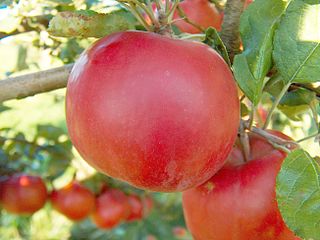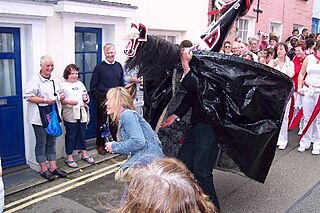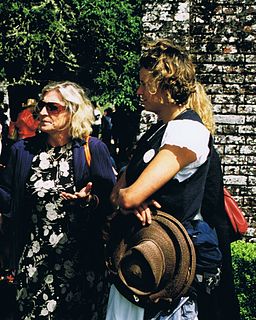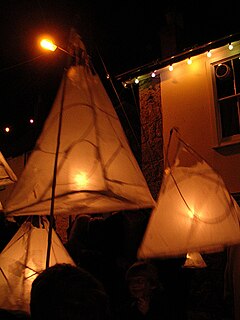 W
WAllantide, also known as Saint Allan's Day or the Feast of Saint Allan, is a Cornish festival that was traditionally celebrated on the night of 31 October, as well as the following day time, and known elsewhere as Allhallowtide. The festival in Cornwall is the liturgical feast day of St Allan, who was the bishop of Quimper in the sixth century. As such, Allantide is also known as Allan Night and Allan Day. The origins of the name Allantide also probably stem from the same sources as Hollantide and Hallowe'en itself.
 W
WThe annual Bodmin Riding custom was held at Bodmin in Cornwall, England, UK, on the Sunday and Monday after 7 July. Accounts over its long history vary, but it involved a horseback procession around the town, carrying two large garlands, and probably originated as a Guild Riding custom. The earliest documentary evidence of the custom is in the Bodmin Parish Church rebuilding accounts of 1469-72, and it ceased in the early 19th century, but was revived in 1974 and now forms part of Bodmin Riding and Heritage Day Festival.
Bolster day is annual festival held at Chapel Porth cove near St Agnes, Cornwall, UK. The festival is held on the Sunday before the early Spring Bank Holiday in May every year and reenacts the events of the Cornish legend of Bolster the giant and Saint Agnes with use of giant puppets and local performers. During the day there are also Cornish dance displays and other entertainments.
 W
WThe cultural calendar of Cornwall is punctuated by numerous historic and community festivals and celebrations. In particular there are strong links between parishes and their patronal feast days. There is also a tradition of holding celebrations associated with tin mining and fishing.
Hurling is an outdoor team game played only in Cornwall, United Kingdom. It is played with a small silver ball. The sport is not to be confused with the Irish game, also called hurling; the two sports are fundamentally different in equipment and game-play.
 W
WCrying The Neck is a harvest festival tradition once common in counties of Devon and Cornwall in the United Kingdom in Europe. The tradition declined following the invention of machines such as the combine harvester.
 W
WThe most famous Furry Dance, takes place in Helston, Cornwall, UK. It is one of the oldest British customs still practised today. However the modern variant of the dance holds few similarities with the proposed original, having been revived long after the event had died out. The dance is very well attended every year and people travel from all over the world to see it: Helston Town Band play all the music for the dances.
 W
WGolowan is the Cornish language word for the Midsummer celebrations in Cornwall, UK; widespread prior to the late 19th century and most popular in the Penwith area and in particular Penzance and Newlyn. The celebrations were centred on the lighting of bonfires and fireworks and the performance of associated rituals. The midsummer bonfire ceremonies were revived at St Ives in 1929 by the Old Cornwall Society and since then spread to other societies across Cornwall, as far as Kit Hill near Callington. Since 1991 the Golowan festival in Penzance has revived many of these ancient customs and has grown to become a major arts and culture festival; its central event 'Mazey Day' now attracts tens of thousands of people to the Penzance area in late June.
 W
WGuldize, Gooldize or Goel dheys is the harvest festival of the Cornish people. Guldize is Cornish language for "the feast of ricks". The festival was held at the end of the wheat harvest and took the form of a vast feast usually around the time of the autumnal equinox. The ceremony of Crying The Neck took place before the feast, the neck being formed into a Corn dolly, which presided over the celebrations. Since 2008 a revived Guldize celebration has been held in Penzance and since 2010 in several other locations across Cornwall.
 W
WJohn Knill born at Callington in Cornwall was a slightly eccentric mayor of St Ives, Cornwall, UK, in 1767 and Collector of Customs at St Ives from 1762 to 1782. He built his own memorial, a 15-metre (49 ft) high granite obelisk known as Knill's steeple. This obelisk was sited on the summit of Worvas hill with views over St Ives Bay, with the intention that he should be buried in a vault within it, but his body was interred in St Andrew's Church, Holborn. The steeple bears on one side the painted coat of arms of Knill, with the Latin Nil Desperandum ; also inscribed on the monument are the words of Johannes Knill 1782, Resurgam, and, in English, I know that my Redeemer liveth.
 W
WLafrowda Day is an annual festival of arts and music held on the third Saturday in July every year in the town of St Just in Penwith in Cornwall. The Lafrowda Festival is a Registered Charity No: 1090446. Lafrowda is an ancient name for the St Just area and pronounced LaTHROWda. The 2016 Lafrowda Day Festival was the 20th year it has been held.
 W
WMarhamchurch is a civil parish and village in north Cornwall, England, United Kingdom.
 W
WThe 'Obby 'Oss festival is a folk custom that takes place each May Day in Padstow, a coastal town in North Cornwall. It involves two separate processions making their way around the town, each containing an eponymous hobby horse known as the 'Obby 'Oss.
 W
WPicrous Day was a festival celebrated by the tin miners of Cornwall on the First Thursday before Christmas. This is believed to be the feast of the discovery of tin by a man named Picrous whom miners in the East of Cornwall celebrated as the founder of their industry instead of St Piran.
 W
WSaint Piran's Day, or the Feast of Saint Piran, is the national day of Cornwall, held on 5 March every year. The day is named after one of the patron saints of Cornwall, Saint Piran, who is also the patron saint of tin miners.
 W
WThe Port Eliot Lit Fest is an annual celebration of all things literary taking place at Port Eliot in Cornwall, in the United Kingdom. It was founded by the late Jago Eliot. Guests who have attended the festival in past years are Hanif Kureishi, James Flint, Hari Kunzru and Louis de Bernières.
 W
WTom Bawcock's Eve is an annual festival, held on 23 December, in Mousehole, Cornwall, England.
 W
WThe West Cornwall May Day celebrations are an example of folk practices found in the western part of Cornwall, England, United Kingdom, associated with the coming of spring. The celebration of May Day is a common motif throughout Europe and beyond. In Cornwall there are a number of notable examples of this practice including the Obby Oss in Padstow and Furry Dance or Flora day in Helston. The celebrations are in contrast to the Cornish midwinter celebrations that occur every year such as the Penzance Montol Festival and the Padstow Mummer's Day festival.